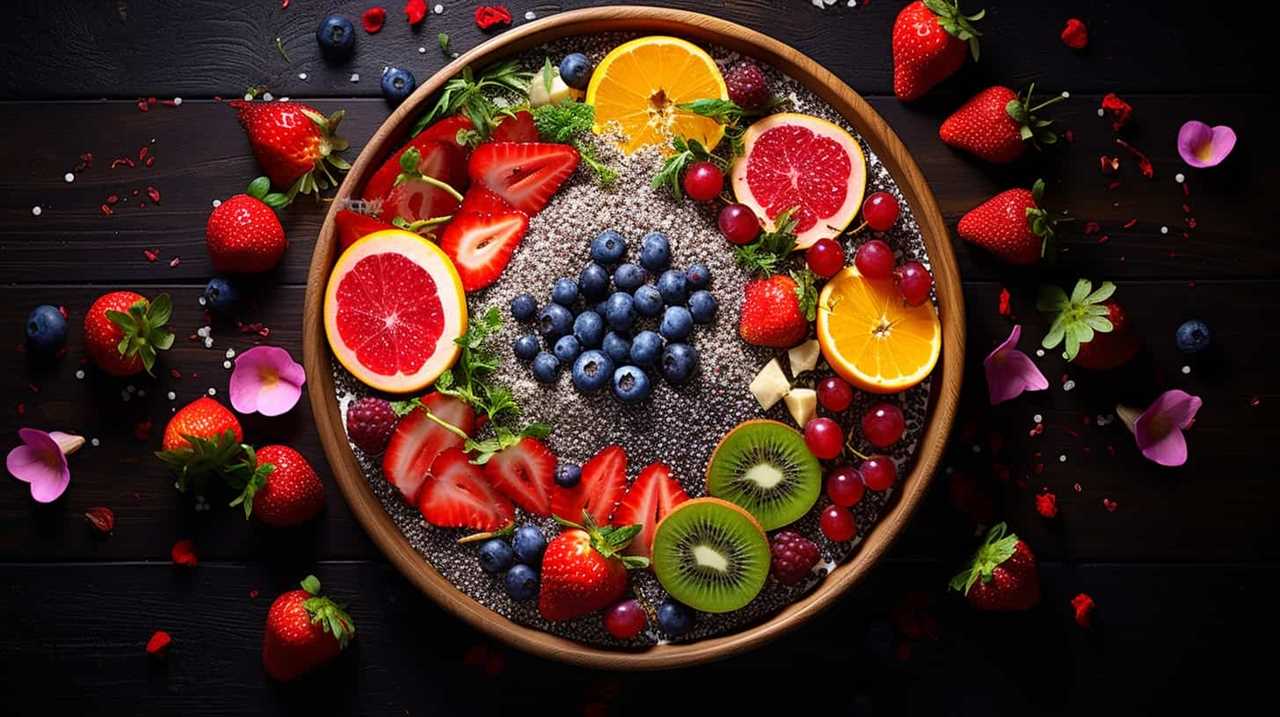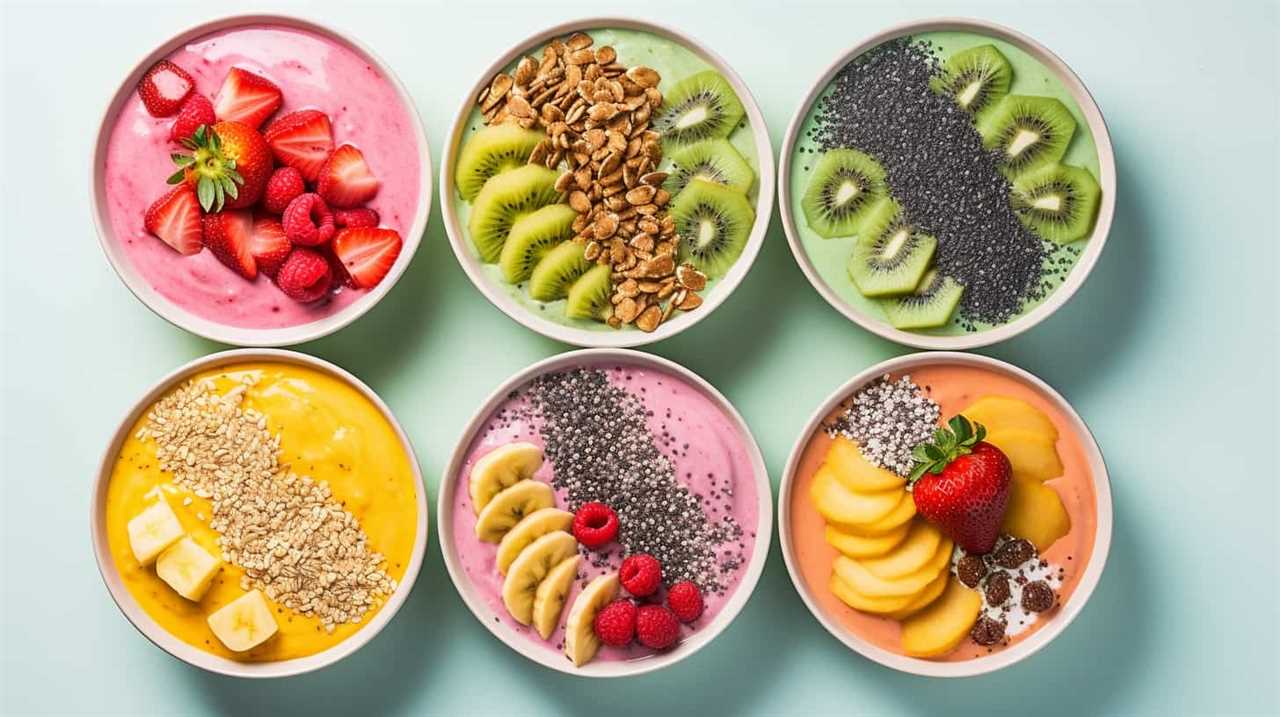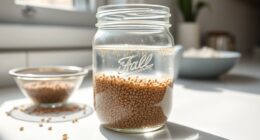We are on the brink of a culinary revolution, where gluten-free baking is being transformed with the power of superfood seeds.
In 2023, we’ll witness the rise of chia seeds as the secret ingredient that takes our gluten-free recipes to new heights.
These tiny seeds, packed with nutritional goodness, will not only enhance the texture and moisture of our baked goods but also serve as a binding agent.
Get ready to indulge in the delicious and nutritious world of gluten-free baking with chia seeds.

Key Takeaways
- Chia seeds can be used as a binding agent in gluten-free baking, improving elasticity and preventing crumbling.
- Chia seeds enhance texture and moisture in baked goods, creating a gel-like consistency and adding crunch.
- Chia seeds are a versatile ingredient that can be used as an egg substitute and to add nutrients to various recipes.
- Incorporating chia seeds in gluten-free baking can provide nutritional benefits such as fiber, omega-3 fatty acids, antioxidants, and minerals.
The Nutritional Benefits of Chia Seeds
In exploring the nutritional benefits of chia seeds, we discovered their remarkable versatility in enhancing gluten-free baking. Chia seeds aren’t only a great addition to your diet but also have numerous health benefits.
They’re packed with fiber, which aids in weight loss by promoting a feeling of fullness and reducing cravings. Additionally, chia seeds are rich in Omega-3 fatty acids, which are known for their heart-healthy properties. These fatty acids can help lower cholesterol levels and reduce the risk of heart disease.
Incorporating chia seeds into your gluten-free recipes is a simple and effective way to boost their nutritional value. Now, let’s delve into the various ways we can incorporate these superfood seeds into our gluten-free recipes and revolutionize the world of baking.
Incorporating Chia Seeds in Gluten-Free Recipes
Now let’s explore how we can incorporate chia seeds into our gluten-free recipes and elevate their nutritional value.

Chia seeds are a versatile ingredient that can be easily incorporated into various dishes to enhance their health benefits. One great way to incorporate chia seeds is by adding them to smoothies. Simply sprinkle a tablespoon of chia seeds into your favorite smoothie recipe to add a boost of fiber, omega-3 fatty acids, and antioxidants.
Another option is to include chia seeds in energy bars. These tiny seeds can provide an extra crunch and a nutritious punch to your homemade energy bars.
By adding chia seeds to your gluten-free recipes, you can enhance their nutritional profile and enjoy the many health benefits these superfood seeds have to offer.
Now, let’s delve into how chia seeds can also serve as a binding agent in baking.

Chia Seeds as a Binding Agent in Baking
To incorporate chia seeds as a binding agent in baking, we can explore their unique properties and how they can enhance the texture and structure of gluten-free baked goods. Chia seeds are known for their ability to absorb liquid and form a gel-like consistency when combined with water. This gel acts as a natural binder, similar to the way eggs or gluten would in traditional baking.
Here are four ways chia seeds can be used as a binding agent:
- Adding chia seeds to gluten-free bread recipes to improve the dough’s elasticity and prevent crumbling.
- Using chia gel as a substitute for eggs in vegan baking, providing the necessary binding properties.
- Incorporating ground chia seeds into cookies or muffins to create a moist and cohesive texture.
- Mixing chia seeds into gluten-free flour blends to enhance their binding capabilities.
Enhancing Texture and Moisture With Chia Seeds
We can achieve enhanced texture and moisture in gluten-free baking by harnessing the power of chia seeds as a binding agent. Chia seeds aren’t only known for their nutritional value, but also for their ability to absorb liquid and form a gel-like substance when mixed with water. This gel-like consistency helps to hold ingredients together, resulting in a moist and tender texture in baked goods.
Additionally, chia seeds can be used as an egg substitute in gluten-free recipes. When mixed with water, chia seeds create a gel that mimics the binding properties of eggs. This makes them a great option for those with egg allergies or for vegans who prefer plant-based alternatives.

In savory dishes, chia seeds can be used to add texture and crunch to recipes such as breads, crackers, and even meatballs. With their versatility and ability to enhance both texture and moisture, chia seeds are truly a game-changer in gluten-free baking.
Now, let’s delve into the next section and explore the various ways in which chia seeds can be used as a versatile ingredient in gluten-free baking.
Chia Seeds: A Versatile Ingredient in Gluten-Free Baking
Chia seeds offer a multitude of possibilities as a versatile ingredient in gluten-free baking. These tiny seeds are packed with nutrients and can be used in various ways to enhance the texture and taste of gluten-free baked goods.
Here are some ways you can incorporate chia seeds into your gluten-free baking:

- Chia seeds as an egg substitute: When mixed with water, chia seeds form a gel-like substance that can be used as an egg replacement in baking. This is especially helpful for those with egg allergies or following a vegan diet.
- Chia seeds in smoothies: Adding chia seeds to your smoothies not only adds a nutritional boost but also helps to thicken and create a creamy texture. They can also help to keep you feeling fuller for longer.
- Chia seed pudding: Chia seeds can be mixed with milk or a dairy-free alternative to create a delicious and nutritious pudding. You can add flavors like vanilla or cocoa powder to enhance the taste.
- Chia seed crusts: Ground chia seeds can be used as a gluten-free alternative to breadcrumbs for coating meats or creating crusts for pies and tarts.
With their versatility and nutritional benefits, chia seeds are a great addition to any gluten-free baking recipe.
Frequently Asked Questions
How Do Chia Seeds Compare to Other Superfood Seeds in Terms of Nutritional Benefits?
Chia seeds offer numerous nutritional benefits compared to flax seeds and hemp seeds. They are rich in omega-3 fatty acids, fiber, protein, and antioxidants. Incorporating chia seeds into your diet can support overall health and well-being.
Can Chia Seeds Be Used as a Substitute for Eggs in Gluten-Free Baking?
Yes, chia seeds can be used as a substitute for eggs in gluten-free baking. They have a similar nutritional value to other egg substitutes and can act as a binding agent in non-baking gluten-free recipes.
What Are Some Creative Ways to Incorporate Chia Seeds Into Gluten-Free Recipes Other Than Baking?
Incorporating chia seeds into smoothies and exploring chia seed pudding variations are creative ways to utilize the nutritional benefits of these superfood seeds in gluten-free recipes.

Do Chia Seeds Have Any Potential Side Effects or Allergenic Properties?
Chia seeds, a rich source of omega 3 fatty acids, may have potential side effects such as bloating or diarrhea in some individuals. However, these effects are rare and can be minimized by consuming them in moderation.
Are There Any Specific Guidelines or Ratios to Follow When Using Chia Seeds as a Binding Agent in Gluten-Free Baking?
When using chia seeds as a binding agent in gluten-free baking, there are specific guidelines and ratios to follow. These guidelines ensure that the chia seeds effectively bind the ingredients together, resulting in a successful gluten-free recipe.
Conclusion
In conclusion, the incorporation of chia seeds in gluten-free baking has revolutionized the industry by providing a nutrient-rich alternative to traditional binding agents.
With their ability to enhance texture and moisture, chia seeds have become a versatile ingredient that adds both nutrition and flavor to gluten-free recipes.

Their small yet powerful presence in the baking world is like a sprinkle of stardust, transforming ordinary gluten-free treats into extraordinary superfood delights.









